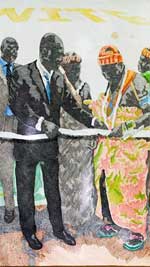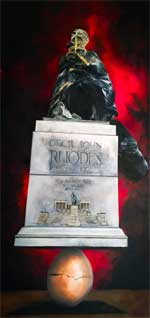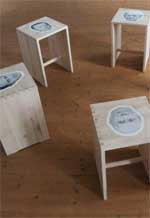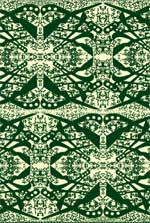
In the following, we have selected new artworks for the category of memory, but – for purposes of comparability – mainly artworks that are related to memories of historical, political events as well as daily life. In this way, the different forms of memories become clearer: memories not only refer to specific events encountered directly as a participant. Rather, collective memory also articulates what we call experiences (rather than events). These experiences are either based on perceptions, interpretations, reflections of events or they are ‘grand narratives’ (narrations, tales, myths). The works in the exhibition can thus be placed in this chart on a sliding scale from factual to fictional.
Factual events
Dieudonné Assiga, L’unité: In his painting, Dieudonné Assiga from Douala, Cameroon, shows us his interpretation of a historical event in his country. The conflicts between the Francophone and Anglophone zones in Cameroon had led to violent clashes in 2017. In a ‘National Dialogue’ in 2019, the parties involved tried to save the unity of the country through reconciliation negotiations. In his painting Dieudonné Assiga has recreated, in a symbolic way, the political gathering based on this historical event.
David Ochieng, Soko Adventures: In contrast, David Ochieng's animation tells of an everyday experience of a market in Nairobi. The artist is from Nairobi, and he obviously shows a chase in the digital animation. Perhaps a trader chasing a thief? When we hear the word market, it immediately conjures an image in our minds of mobile stalls, piles of goods, people crowded together, colourful movement. These images are obviously deeply imprinted on our minds, and thus a typical example of (visual) collective memory, which refers to concrete, social experiences in everyday life.
Perceptions, interpretations and reflections
Tlotlo Sereisho, Rhodes Must Fall, a Mengelmoes: Tlotlo Sereisho, on the other hand, refers in his painting to the historical movement to topple the Rhodes Monument(s) in South Africa in 2015. In this respect, his work resembles that of Dieudonné Assiga which commemorates a political event in Cameroon. And again, it is not the concrete event, in this case the toppling of the monument, that is shown, but a complex montage of an egg, a pedestal and a wrapped monument (which could also be unwrapped again) against an unreal, flickering background. In this way, Tlotlo Sereisho detaches himself from the event (which, however, remains present) and articulates his perception and interpretation of the situation in South Africa. He asks about the "prevalent practices around commemoration and nation building" (Tlotlo Sereisho in his comment) and understands his painting as "an exhortation to continue the (still pending) overcoming of apartheid".
Gonca Sağlam, Polittalk: The work by Gonca Sağlam from the German section of the exhibition shows a similar appellative character. In her work Polittalk she depicts the faces that are currently engraved in the global collective memory of our time. We see Putin, Assad, Kim Jong-un, Erdogan, Trump. The circle speaks of conspiratorial meetings. This takes on a special relevance since the invasion of the Russian army under Putin into the Ukraine. Such talks, such meetings, such agreements do indeed exist, with massive repercussions for humanity. It is about power. But this specific meeting did not and will not take place. The theme is no longer a concrete experience, but an interpretation of world events as a narrative of the banality of power, secured in understandings between politicians of questionable reputation.
‘Grand narratives’: slavery, resistance, freedom
Already the previous section on ‘interpretations’ made clear that facts, events, incidents in history are always interpreted against specific narrations. In this exhibition we can even find examples that mainly address those narratives. This means that the respective memories are shaped as such.
The last two examples that show this in a complex way are from Ghana. They still reference a historical tradition (historical reports and artefacts), but from there something of their own develops, a general narrative, the first one through a penetration of the private (Daniel Adofo), the other one (Nyameba Prince Anim), with regard to society as a whole, through an extreme form of abstraction. Here, the focus is on the major themes of humanity: enslavement and freedom.
Daniel Adofo, Shackles of a Freeman: The slave castles stood and still stand on the coast of Ghana, shaping the perception of Ghana’s history, for Ghanaians and for visitors. Daniel Adofo from Winneba, Ghana, starts with his experience in his work Shackles of a Freeman. But in the commentary, the artist then fuses the collective memory with his own reflections regarding society but also with his self-perception (against the narrative). First, he is using the history of slavery as a mirror for the current situation of many African countries. But then and above all - and this is central - he mirrors his own experience in the historical experience of slavery. He sees his own life journey as an artist in the tension between freedom and enslavement. This entanglement determines his current mood and self-appraisal.
Nyameba Prince Anim, Yaa Asantewaa: In his digital prints on fabrics, Nyameba Prince Anim, also from Winneba, refers to heroes who contributed to the development of Ghana. In Yaa Asantewaa he thematises the story of the queen mother Yaa Asantewaa who led a rebellion against the British colonisers in the late 19th century: “a strong and courageous woman who stood up and fought for the peace and freedom of Ghana” (Nyameba Prince Anim in his comment). For his pattern design he used “gun and sword … as representational portrait of Yaa Asantewaa” (Nyameba Prince Anim in his comment).
But the guns and swords are not easy to distinguish. They almost disappear in the abstract pattern, which initially speaks of ornamental, abstract decoration. Nevertheless, under this decorative appearance there lies a highly complex meaning. The decorative surface collapses. In these contradictions and fractures, a story comes to the fore that is perhaps also contradictory and fractured in itself.
Continue with part 3, the exploration of different types of strategies applied by the artists: Link






